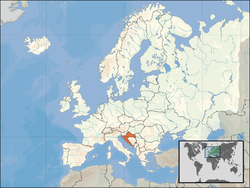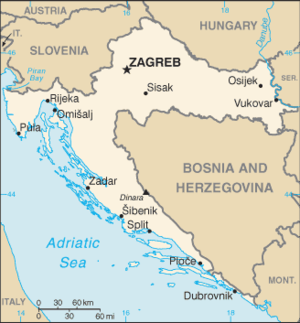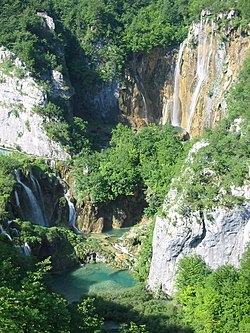Croatia
Republic of Croatia Republika Hrvatska | |
|---|---|
| Motto: none (Historically "Antemurale Christianitatis" (Latin), "Bulwark of Christianity") | |
| Anthem: Lijepa naša domovino "Our beautiful homeland" | |
 Location of Croatia (orange) in Europe (white) | |
| Capital and largest city | File:Zagreb coat of arms.gif Zagreb |
| Official languages | Croatian1 |
| Government | Republic |
| Stjepan Mesić | |
| Ivo Sanader | |
| Independence | |
June 25 1991 | |
• from Habsburg monarchy | October 29 1918 |
from 1526 | |
| 925 | |
| March 4 852 | |
• Founded | First half of 7th century |
• Water (%) | 35.44 |
| Population | |
• July 2005 estimate | 4,551,000 (115th) |
• 2001 census | 4,437,460 |
| GDP (PPP) | 2006 estimate |
• Total | $69,834 billion (67th) |
• Per capita | $15,550 (52nd) |
| HDI (2004) | Error: Invalid HDI value (44th) |
| Currency | Kuna (kn) (HRK) |
| Time zone | UTC+1 (CET) |
• Summer (DST) | UTC+2 (CEST) |
| Calling code | 385 |
| ISO 3166 code | HR |
| Internet TLD | .hr |
Croatia (Template:Lang-hr ), officially the Republic of Croatia (Republika Hrvatska), is a country in Europe at the crossroads of the Mediterranean and Central Europe. Its capital is Zagreb. Croatia shares land borders with Slovenia and Hungary on the north, Serbia on the east, Bosnia and Herzegovina on the south and east, and Montenegro on the south, as well as a sea border with Italy to the west. It is a candidate for membership in the European Union and NATO.
History
A slavic tribe of Croats came to the Roman provinces of Dalmatia and Pannonia in the seventh century and ultimately assimilated the larger native Illyro-Roman population, which took the Croat name. Ruled by various Croatian rulers, these people were intermittently threatened by the Byzantine Empire and the Franks.Croatia became an independent Monarchy in 925, when King Tomislav was crowned the first King of Croatia by a decree of the Pope.
Croatia retained its independence until 1102, when, after decades of inner struggles, the country entered a dynastic union with the Kingdom of Hungary under the name "Lands of the Crown of St. Stephen". Croatian statehood was preserved through a number of institutions, notably the Sabor which served as an assembly of Croatian nobles, and the ban or viceroy. Furthermore, the Croatian nobles retained their lands and titles.
By the mid-1400s, the Hungarian kingdom was shaken by Ottoman expansion as much of the mountainous country now known as Bosnia and Herzegovina fell to the Turks. At the same time, Dalmatia came mostly under Venetian rule. Dubrovnik was a city-state that was, at first, under the protection of the Byzantine Empire and, after crusades, under the sovereignty of Venice (1205–1358), but later, unlike other Dalmatian city-states, became independent as Ragusa Republic.
The Battle of Mohács in 1526 led the Croatian Parliament to elect the Habsburgs to the throne of Croatia. Habsburg rule eventually thwarted Ottoman expansion, and by the Eighteenth century, many of the Croatian territories that had previously been Ottoman passed to the Austrians. The odd crescent shape of the Croatian lands remained as a mark, more or less, of the northern frontier of the Ottoman advance into Europe. Further south, Istria, Dalmatia and Dubrovnik all eventually passed to the Habsburg Monarchy between 1797 and 1815.
Following World War I, Croatia joined the State of Slovenes, Croats and Serbs. Shortly thereafter, this joint state entered into a union with Serbia to form the Kingdom of Serbs, Croats and Slovenes, which eventually became Kingdom of Yugoslavia in 1929. After Germany and its Axis allies invaded Yugoslavia in April 1941, the Nazis permitted the extreme right-wing organization Ustaše, backed and sponsored by Italian fascists, to create the "Independent State of Croatia". The new regime was highly dependent upon German support for survival. Numerous concentration camps were established in Croatia between 1941 and 1945, when many Serbs, Jews, Gypsies, anti-fascist Croats and others were murdered for racial, religious or political reasons. When the Axis powers were defeated in Croatia by the anti-fascists, the State Anti-Fascist Council of People's Liberation of Croatia (ZAVNOH) declared the People's Republic of Croatia, which became one of the six socialist republics within federal Yugoslavia under the rule of Josip Broz Tito. After his death, the economic and political crises that the Federation faced multiplied and escalated.
Along with Slovenia, Croatia declared its independence from Yugoslavia on June 25, 1991, triggering Serbian military action towards Croatia and starting the Croatian War of Independence. Early on, the Serb population living in Croatia revolted and were supported by the Yugoslav army and paramilitary extremist groups from Serbia, under the guidance of Serbian president Slobodan Milošević, and aggression on eastern Croatia came directly from Serbian teritory. The ensuing months saw combat between newly established Croatian Army and joint heavily armed Yugoslav/Serb armed forces. Following this stage of the war, the independence of Croatia was internationally-recognized. The war ended in 1995, after the Croatian Army successfully launched two major military operations to retake the occupied areas. The war left hundreds of thousands refugees on both sides, and thousands were killed either in battle or by ethnic cleansing.
The country was in a perilous state at the time of death of president Franjo Tuđman in December 1999. The HDZ lost power after the presidential and parliamentary elections at the beginning of 2000, which ushered in a new era of politicians who pledged commitment to political and economic reforms and Croatia's integration into the European mainstream. The left-centre coalition government was led by the SDP until November 2003, when the reformed HDZ formed minority government. President Stjepan Mesić, coming from centrist/liberal party HNS, was elected two times, in 2000 and 2005. The constitution has been changed to shift power away from the president to the parliament. Croatia has joined the World Trade Organization and opened up the economy, making it grow and inflation was kept under control. It joined NATO's Partnership for Peace program and became an official candidate for membership in that alliance. By early 2003 it had made sufficient progress to apply for European Union membership, becoming the second EU candidate country from former Yugoslavia, after Slovenia (who joined the EU on May 1, 2004). Accession negotiations were opened on October 3 2005, and the country is expected to become an EU member state in 2009 or 2010.
Geography

Croatia is located in Southern Europe. Its shape resembles that of a crescent or a horseshoe, which flanks its neighbours Serbia, Bosnia and Herzegovina and Montenegro. To the north lie Slovenia and Hungary; Italy lies across the Adriatic Sea. Its mainland territory is split in two non-contiguous parts by the short coastline of Bosnia and Herzegovina around Neum.

Its terrain is diverse, including:
- plains, lakes and rolling hills in the continental north and northeast (Central Croatia and Slavonia, part of the Pannonian plain);
- densely wooded mountains in Lika and Gorski Kotar, part of the Dinaric Alps;
- rocky coastlines on the Adriatic Sea (Istria, Northern Seacoast and Dalmatia).
The country is famous for its many national parks.
Croatia has a mixture of climates. In the north and east it is continental, Mediterranean along the coast and a semi-highland and highland climate in the south-central region. Offshore Croatia consists of over one thousand islands varying in size.
National Geographic Adventure Magazine named Croatia as Destination of the Year in 2006.*[1]
Politics
Since the adoption of the 1990 Constitution, Croatia has been a democratic republic. Between 1990 and 2000 it had a semi-presidential system, and since 2000 it has a parliamentary system.
The President of the Republic (Predsjednik) is the head of state, directly elected to a five-year term and is limited by the Constitution to a maximum of two terms. In addition to being the commander in chief of the armed forces, the president has the procedural duty of appointing the Prime minister with the consent of the Parliament, and has some influence on foreign policy.
Template:Croatia membership The Croatian Parliament (Sabor) is a unicameral legislative body (a second chamber, the "House of Counties", which was set up by the Constitution of 1990, has been abolished in 2001 [1]). The number of the Sabor's members can vary from 100 to 160; they are all elected by popular vote to serve four-year terms. The plenary sessions of the Sabor take place from January 15 to July 15, and from September 15 to December 15.
The Croatian Government (Vlada) is headed by the Prime minister who has two deputy prime ministers and fourteen ministers in charge of particular sectors of activity. The executive branch is responsible for proposing legislation and a budget, executing the laws, and guiding the foreign and internal policies of the republic.
Croatia has a three-tiered judicial system, consisting of the Supreme Court, county courts, and municipal courts. The Constitutional Court rules on matters regarding the Constitution.
The yearly Reporters Without Borders' press freedom rankings for Croatia from 2002 to 2006 are: 33rd · 69th · 54th · 56th · 53rd
Administrative divisions



Croatia is divided into twenty-one counties (županija) and the capital Zagreb's city district (in italics below):
| Anglicized name | Native name | |
| 1 | Zagreb | Zagrebačka |
| 2 | Krapina-Zagorje | Krapinsko-zagorska |
| 3 | Sisak-Moslavina | Sisačko-moslavačka |
| 4 | Karlovac | Karlovačka |
| 5 | Varaždin | Varaždinska |
| 6 | Koprivnica-Križevci | Koprivničko-križevačka |
| 7 | Bjelovar-Bilogora | Bjelovarsko-bilogorska |
| 8 | Primorje-Gorski Kotar | Primorsko-goranska |
| 9 | Lika-Senj | Ličko-senjska |
| 10 | Virovitica-Podravina | Virovitičko-podravska |
| 11 | Požega-Slavonia | Požeško-slavonska |
| 12 | Brod-Posavina | Brodsko-posavska |
| 13 | Zadar | Zadarska |
| 14 | Osijek-Baranja | Osječko-baranjska |
| 15 | Šibenik-Knin | Šibensko-kninska |
| 16 | Vukovar-Srijem | Vukovarsko-srijemska |
| 17 | Split-Dalmatia | Splitsko-dalmatinska |
| 18 | Istria | Istarska |
| 19 | Dubrovnik-Neretva | Dubrovačko-neretvanska |
| 20 | Međimurje | Međimurska |
| 21 | City of Zagreb | Grad Zagreb |
Economy
Croatia economy is service based with service sector accounting for 67% of total GDP. Industrial sector is dominated by shipbuilding, food processing and chemical industry taking a significant portion of Industrial output.
Croatia's largest companies are Agrokor, Ina, Pliva, Podravka, HEP and Croatian Telecom.
Industrial Sector represents 27% of Croatia’s total economic output and agriculture represents 6%.
Agricultural sector in Croatia started to thrive in recent years, and exports of blue water fish has experienced great success, as well as organic foods, Wines, Olive Oils and Lavender.
Tourism is a notable source of income during the summer. With 10.4 million foreign tourists a year it generates revenue of 7 billion euros, Croatia is ranked 18th most popular tourist destination in the world. [2]
Trade is starting to play major role in Croatian Economic Output. In 2006 Croatia exported goods in value of 10.4 U$ billion (FOB) and Imported 21.2 U$ billion (CIF) worth of goods.
The estimated Gross Domestic Product per capita in purchasing power parity in 2006 was USD 15,550 or 53.2% of the EU average for the same year. Latest data released by Croatian National Bank, Croatian economy grew at 4.7% in 2006, preliminary nominal GDP for 2006 has reached 45.4 billion US dollars (256.4 billion Kuna), giving an average income of 10100 U$ per head.
The Croatian economy is post-communist. In the late 1980s, at the beginning of the process of economic transition, its position was favorable, but it was gravely impacted by de-industrialization, war destruction as well as losing the markets of Yugoslavia and the SEV.
Persistent economic problems still remain; high unemployment (15.7% in 2006) and slow progress of economic reforms. Of particular concern is the heavily backlogged judiciary system, combined with inefficient public administration, especially issues of land ownership. The unemployment is very high in eastern parts of Croatia (Slavonia and Dalmatia), reaching 20% in some areas, and relatively low in larger cities, Istria, Kvarner, Zagreb-area, being under 7%. Unemployment has been constantly declining by 5% over the last 7 years. [3]
The country has since experienced faster economic growth and has been preparing for membership in the European Union, its most important trading partner.
In February 2005, the Stabilization and Association Agreement with the EU officially came into force and Croatia is advancing towards full EU membership. The country expects some major economic impulses and high growth rates in the coming years (currently Croatia suffers from high export deficit and considerable debt). Croatia is expecting a major boom in investments, especially greenfield investments.
Demographics

The population of Croatia has been stagnating over the last decade. The 1991–1995 war in Croatia had previously displaced large parts of the population and increased emigration. Some Croats who fled the country during the war are returning. The natural growth rate is minute or negative (less than ± 1%), as the demographic transition has been completed half a century ago. Average life expectancy is approximately 75 years, and the literacy rate is 98.5%.
Croatia is inhabited mostly by Croats (89.9%). There are around twenty minorities, Serbs being the largest one (4.5%) and others having less than 0.5% each. The predominant religion is Catholicism (87.8%), with some Orthodox (4.4%) and Sunni Muslim (1.3%) minorities.
The official and common language, Croatian, is a South Slavic language, using the Latin alphabet. Less than 5% of the population cites other languages as their mother tongues.
| Ethnicity | Population | % of total |
|---|---|---|
| Croats | 3,977,171 | 89.63 |
| Serbs | 201,631 | 4.54 |
| Bosniaks | 20,755 | 0.49 |
| Italians | 19,636 | 0.44 |
| Hungarians | 16,595 | 0.37 |
| Albanians | 15,082 | 0.34 |
| Slovenians | 13,173 | 0.30 |
| Czechs | 10,510 | 0.24 |
| Roma | 9,463 | 0.21 |
| Montenegrins | 4,926 | 0.11 |
| Slovaks | 4,712 | 0.11 |
| Macedonians | 4,270 | 0.10 |
There is also a sizeable German/Austrian minority and also an increasing Chinese population in Zagreb and the other bigger cities, estimated at between 1,500 to 3,000.[4]
Culture
Croatian culture is based on a thirteen century-long history during which the country has attained many monuments and cities, which gave birth to a number of historical figures. The country includes six World Heritage sites and eight national parks. Among a list of notable people that came from Croatia are two Nobel prize winners, and numerous inventors. Some of the world's first fountain pens, came from Croatia.
Croatia also has a place in the history of clothing as the origin of the necktie (cravat). The country has a long artistic, literary and musical tradition. Of particular interest is the diverse nature of cuisine.
See also
- Communications in Croatia
- Holidays in Croatia
- Military of Croatia
- Protected areas of Croatia
- Tourism in Croatia
- Transport in Croatia
- Football (soccer) in Croatia
- Croatian War of Independence
Lists
References
- Template:Hr icon Agičić et al., Povijest i zemljopis Hrvatske, priručnik za hrvatske manjinske škole (History and Geography of Croatia, a handbook for Croatian minority schools), Biblioteka Geographica Croatica, 292 pages, Zagreb:2000 (ISBN 953-6235-40-4)
Notes
Further Reading
- Ivo Banac, The National Question in Yugoslavia: Origins, History, Politics Cornell University Press, 1984.
- Sharon Fisher, Political Change in Post-Communist Slovakia and Croatia: From Nationalist to Europeanist New York: Palgrave Macmillan, 2006. ISBN 1-4039-7286-9
- Mirjana Kasapovic (ur.), Hrvatska politika 1990.-2000. Zagreb: Hrvatska politologija 2001.
- Pavol Demes and Joerg Forbrig (eds.). Reclaiming Democracy: Civil Society and Electoral Change in Central and Eastern Europe. German Marshall Fund, 2007. ISBN 978-80-969639-0-4
External links
- The Croatian government's official website @ vlada.hr
- Basic facts, website of the Croatian Ministry of Foreign Affairs
- Croatian National Tourist Board @ croatia.hr
- General information about Croatia @ www.hr
- Croatia - Overview of History, Culture, and Science
- United Nations Development Programme: Croatia
- Croatian World Network (Croatia.org)


